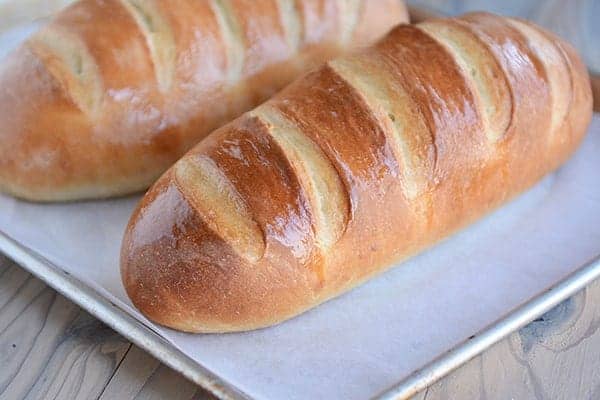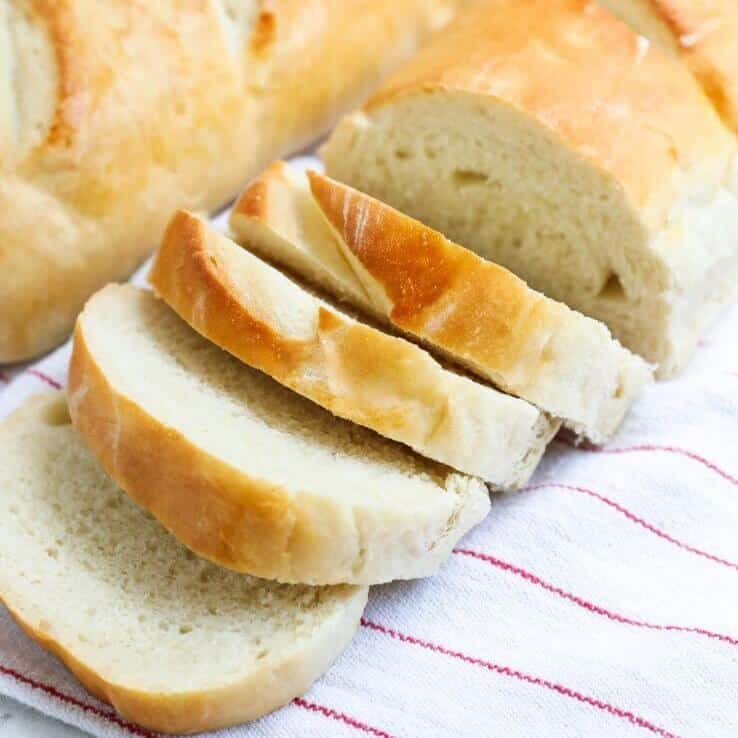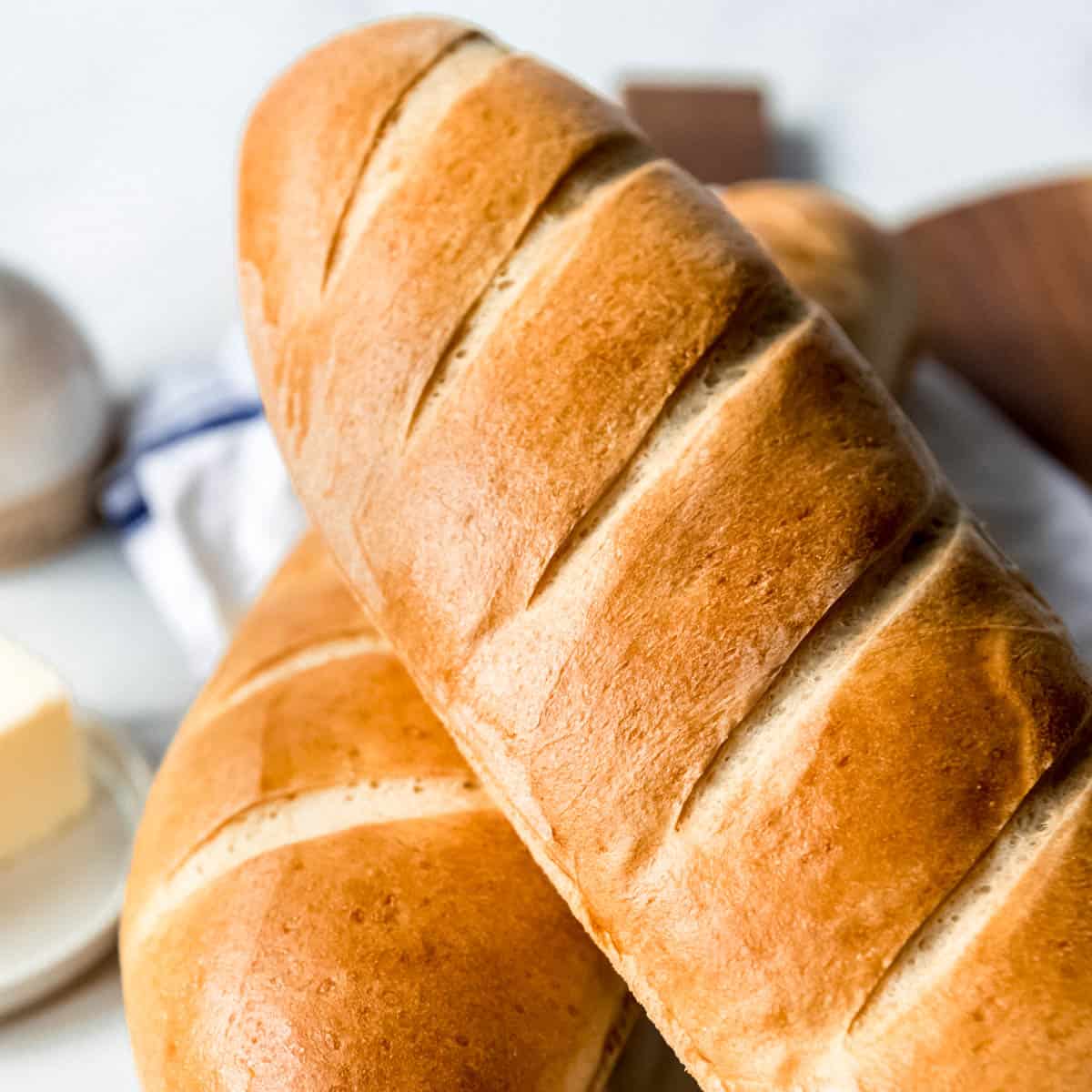The BEST homemade french bread recipe made in just 90 minutes! So easy to make and comes out golden and crispy on the outside, while remaining soft and chewy on the inside.
Homemade bread is one of my favorite things to make. It can seem a bit intimidating at first, but this easy french bread recipe is a great place to start. It has a quick rising time and takes only 90 minutes from start to finish. If you’re a beginner to bread baking, make sure to check out my 3 ingredient artisan bread and my 45-minute breadsticks. Both are so simple along with my favorite dinner rolls and french bread rolls!
If you’re looking for an easy french bread recipe, this is it! You’ll have 2 beautiful loaves in 90 minutes. The actual time you’ll be working will only be about 15 minutes, the rest of the time will be patiently waiting for the dough to rest/rise. This homemade french bread is golden and crispy on the outside, while remaining soft and slightly chewy on the inside. We love to serve it with a bowl of warm soup and the first time I made it, my husband said “this bread is SO good, where did you get it?” He thought I picked it up from our local bakery. It is just that good and really so easy to make. You’ll never want to buy store bought french bread again.
I absolutely love making bread and rolls of all kinds. There’s something so satisfying about making them in your own kitchen. The smell is unbelievable. We love to serve this homemade french bread with softened butter, honey and/or jam. So so good. Trust me when I say, this is the best french bread recipe!
Since this recipe makes two loaves, sometimes we freeze one of them for later. To freeze, wrap the bread tightly in foil or saran wrap (make sure it has cooled completely). Then place in a zip top bag and store in the freezer for up to 2 months.

Easy Homemade French Bread

Prep: 195min
Total: 220min
Yield: 24
Serving Size: 1 Slice
Nutrition Facts: servingSize 1 Slice, calories 233 kcal, Carbohydrate 47 g, Protein 6 g, Fat 2 g, Saturated Fat 1 g, Sodium 220 mg, Fiber 2 g, Sugar 1 g
Ingredients:
- 2 1/4 cups warm water, 110-115 degrees F
- 2 tablespoons granulated sugar
- 1 tablespoon instant or active dry yeast (see note)
- 2 1/4 teaspoons salt (see note)
- 2 tablespoons olive oil, canola oil, vegetable oil or avocado oil
- 5 1/2 – 6 cups all-purpose flour or bread flour (see note)
Instruction:
- In the bowl of an electric stand mixer fitted with the dough hook, combine the water sugar and yeast. If using active dry yeast, let the mixture bubble and foam before proceeding (this can take 3-5 minutes). If using instant yeast, proceed with the recipe (no need to let the yeast activate).
- Add the salt, oil and 3 cups of flour and mix. Add in 2 1/2 to 3 more cups of flour gradually. The dough should clear the sides of the bowl and form a soft ball that doesn’t leave a lot of dough residue on your fingers.
- Knead for 2-3 minutes until the dough is smooth. If the dough starts to cling to the sides of the bowl (or the center column if using a Bosch or other mixer with a center), add 1/4 cup of flour at a time until a sturdy but soft ball of dough forms.
- Rising Method 1: Leave the dough in the mixer, cover with a lid or towel, and let the dough rest for 10 minutes. Stir it down by turning on the mixer for 10 seconds or so. Repeat the “rest and stir down” cycle five more times.
- Rising Method 2: Instead of letting the dough rest for 10 minute spurts and then stirring it down, transfer the dough to a lightly greased bowl and cover with a towel or greased plastic wrap. Let the dough rise until doubled, about an hour or so, depending on the warmth of your kitchen.
- Turn the dough onto a lightly greased surface and divide in half. Pat each section into a thick rectangle, 9X13-inches or thereabouts (doesn’t have to be exact). Roll the dough up starting from the long edge, pressing out any air bubbles or seams with the heel of your hand, and pinch the edge to seal. Arrange seam side down on a large baking sheet lined with parchment paper (I use separate baking sheets for each loaf).
- With a bread lame, razor blade or VERY sharp knife, cut several gashes at an angle on the top each loaf (you can wait to score the bread until after it rises, but it can easily deflate if the razor/knife isn’t sharp enough).
- Cover the loaves with greased plastic wrap or a kitchen towel, and let rise until noticeably puffy and nearly doubled in size, about an hour.
- Preheat the oven to 375 degrees F and make sure an oven rack is in the center position. If you find your bread isn’t browning as much as you like, preheat the oven to 400 or 425 degrees and/or move the oven rack up one position (watch carefully so the bread, especially the bottom, doesn’t burn).
- Optional: for an extra golden, crisp crust, place the loaves in the preheated oven and immediately toss 3-4 ice cubes on the bottom of the oven. Close the oven door quickly but gently. (See note below!)
- Bake the loaves for 25-30 minutes until golden and baked through.
- If desired, brush melted butter over the hot loaves (this softens the crust a bit, so if you want a crispier crust, don’t butter the top).
Homemade French Bread Recipe

The BEST homemade french bread recipe made in just 90 minutes! So easy to make and comes out golden and crispy on the outside, while remaining soft and chewy on the inside.
Prep: 70min
Total: 90min
Yield: 32
Serving Size: 1 serving
Nutrition Facts: calories 73 kcal, Carbohydrate 15 g, Protein 2 g, Sodium 146 mg, servingSize 1 serving
Ingredients:
- 2 cups warm water (, about 105°F)
- 1 Tablespoon active dry yeast
- 2 1/2 teaspoons granulated sugar
- 5 cups (650 g) all-purpose flour (, more as needed)
- 2 1/2 teaspoons table salt or fine sea salt
- 1 teaspoon olive oil
- Melted salted butter (, optional)
Instruction:
- In a small bowl, combine the warm water, yeast, and sugar. Let sit 5 minutes, or until it begins to foam.
- In a stand mixer fitted with a paddle attachment or in a large mixing bowl, stir together 2 cups flour and salt. Stir in the yeast mixture on medium-low speed or by hand. Knead in 1/2 cup of the remaining flour in increments until the dough is smooth but not sticky (depending on climate you could use more or less than 5 cups). Add more flour as needed.
- Rub the olive oil around the dough ball, cover the bowl with a towel and let rest 15 to 30 minutes. If you have more time, let rise up to 1 hour.
- Turn the dough onto a well-floured surface and divide it in half. Set one half aside. Roll the other half into a rectangle (about 15 inches). Starting from the long side, roll the dough into a cylinder.
- Turn both ends in and pinch the seams closed. Round the edges and place onto a baking sheet. Repeat with the second dough ball. Make three diagonal cuts across the top of each loaf. Cover loaves lightly with a towel. Let rise 30 to 60 minutes (the longer the better, if you have the time).
- Preheat the oven to 400°F. Line a baking sheet with a silicone mat or parchment paper. Bake 17 to 23 minutes, or until the tops are golden brown. When you knock on it, it should sound hollow. If it’s browning too fast, lightly cover with foil and lower the temperature to 375°F.
- Brush the top with melted butter, if desired. Slice and serve while warm.
Homemade French Bread

Who doesn’t love a good, chewy loaf of soft french bread? I can hardly resist a warm slice of bread, slathered in butter, or an entire loaf cut in half and smeared with a garlic butter spread then broiled to make the best garlic bread ever. Learn how to make french bread at home with this best ever, easy Homemade French Bread recipe!
Prep: 15min
Total: 160min
Yield: 20
Serving Size: 1 serving
Nutrition Facts: calories 131 kcal, Carbohydrate 26 g, Protein 4 g, Cholesterol 8 mg, Sodium 238 mg, Sugar 1 g, Fat 1 g, Saturated Fat 1 g, Trans Fat 1 g, Fiber 1 g, unSaturated Fat 2 g, servingSize 1 serving
Ingredients:
- 2 1/4 cups warm water (around 110 degrees F)
- 1 1/2 Tablespoons granulated sugar
- 1 Tablespoon instant or active dry yeast
- 2 teaspoons table salt
- 2 Tablespoons vegetable oil ((olive oil or canola oil also work))
- 5 1/2-6 cups all-purpose or bread flour, (scooped & leveled (776 to 846g))
- 1 large egg (beaten with 1 teaspoon cold water)
- Melted salted butter (for brushing on top of the baked loaves (optional))
Instruction:
- In the bowl of a stand mixer, combine the warm water, sugar, and yeast and let the yeast proof for 5 minutes until foamy (unless using instant yeast, in which case just skip this step and add it with everything in the next step).
- Add the salt, oil, and 3 cups of the flour to the yeast mixture. Mix for 1-2 minutes, just until it starts to combine. Add in the remaining flour about half a cup at a time while the mixer is running on low speed, just until the dough forms into a ball that starts to come away from the sides of the bowl and is tacky to the touch. Continue to knead the dough for 2-3 minutes until smooth, adding a little more flour if the dough starts to stick to the sides of the bowl again. Let the dough rest for 5 minutes, then knead again for another 1-2 minutes.
- Transfer the dough to a large, lightly greased bowl and cover it with a kitchen towel or a piece of plastic wrap sprayed lightly with cooking spray. Let the dough rise in a warm place until doubled in size, about an hour.
- When the dough has risen, turn it out onto a clean counter that has been lightly sprayed with cooking spray and divide the dough into two equal sections. Working with one half of the dough at a time, pat it into a large rectangle, roughly 9×13-inches.
- Roll the dough up starting from the long edges into a tight cylinder, turning the ends under and pinching the edges together to seal. Place seam side down on a perforated French bread pan or baking sheet lined with parchment paper. Repeat with the remaining dough to form the second loaf.
- Cover the loaves with a kitchen towel or a piece of plastic wrap sprayed lightly with cooking spray and let them rise for another 30 minutes, until nearly doubled again in size.
- Preheat the oven to 375°F while the loaves are rising. Just before putting the loaves in the oven, brush with egg wash, if using, and cut several gashes on an angle about 2-inches apart along the top of each loaf using a very sharp knife or baker’s lame.
- Transfer the loaves to the oven and toss 3-4 ice cubes onto the bottom of the oven floor and immediately close the oven door.
- Bake for 25-30 minutes until golden brown. Brush loaves with melted butter after removing from the oven for a softer crust, if desired.
Perfect Homemade French Bread
FAQ
What makes French bread different?
What is the secret of French bread?
What are the three types of French bread?
- Baguette – a long, thin type of bread of French origin. …
- Boule de pain – a traditional shape of French bread resembling a squashed ball. …
- Brioche – has a high egg and butter content, which gives it a rich, tender and tight crumb.
What is the difference between a French loaf and a French Baguette?
